Are you planning a trip to North East India and wondering when is the best time to go? Understanding the ideal season for travel in this enchanting region is crucial to ensure you have the most memorable experience. The weather, cultural festivals, and wildlife sightings vary throughout the year, so choosing the right time to visit can make all the difference.
Few Key Takeaways:
- North East India is best visited between November and May for the most favorable weather conditions and minimal rain.
- The region experiences three distinct seasons – summer, winter, and monsoon – each offering unique attractions and activities.
- Exploring the diverse culture, attending vibrant festivals, and sampling the delicious local cuisine are must-do experiences in North East India.
- Wildlife enthusiasts should plan their visit during the winter months for the best wildlife sightings in national parks like Kaziranga and Manas.
- Planning your itinerary based on the optimal period for each destination will help you make the most of your trip to North East India.
Unveiling the Splendor of North East India’s Seasons
North East India is blessed with a diverse and captivating climate that adds to its cultural richness and natural beauty. The region experiences three distinct seasons – summer, winter, and monsoon. Each season offers a unique charm and a plethora of experiences for travelers to indulge in.
The Charm of North East India’s Summer
During the summer season, which lasts from April to June, North East India welcomes visitors with pleasant weather and comfortable temperatures ranging from 22 to 38 degrees Celsius. This is the ideal time to embark on an exploration of the region’s popular tourist destinations and immerse yourself in its vibrant culture. You can engage in thrilling outdoor activities such as boating, kayaking, and mountain biking while enjoying the lush landscapes that epitomize North East India.
Winter Wonderland in the North East Territory
As the summer fades away, North East India transforms into a winter wonderland, adorned with a blanket of snow in some areas. The winter season, which spans from November to February, offers a respite from the heat with temperatures ranging from 12 to 22 degrees Celsius. This is an enchanting time to witness the majestic beauty of the region’s snow-capped mountains, charming valleys, and frozen lakes. Whether it’s skiing in Auli or reveling in the festivities of Christmas and New Year’s Eve, North East India’s winter is a delight for travelers seeking tranquility and stunning vistas.
Monsoon Beauty: North East India’s Refreshing Showers
When the monsoon arrives in North East India, the region undergoes a breathtaking transformation, with lush greenery, gushing waterfalls, and rejuvenated rivers. The monsoon season, which extends from June to September, receives abundant rainfall and showcases the natural splendor of the region. It’s a perfect time to experience the tranquility of the rain-soaked landscapes and witness the vibrant culture come alive with monsoon festivals like Ambubachi Mela in Assam and Behdienkhlam Festival in Meghalaya.
Immerse yourself in the captivating charm of North East India, as its seasons paint a vivid canvas of culture, natural beauty, and unique experiences.
The Cultural and Natural Beauty of North East India
North East India is renowned for its rich cultural heritage and diverse tribal communities. Each tribe has its own unique traditions, customs, and traditional attire. Immersing yourself in the local culture is a must during your visit, whether it’s attending vibrant festivals like the Hornbill Festival or witnessing traditional dances like the Bihu and Bamboo Dance.
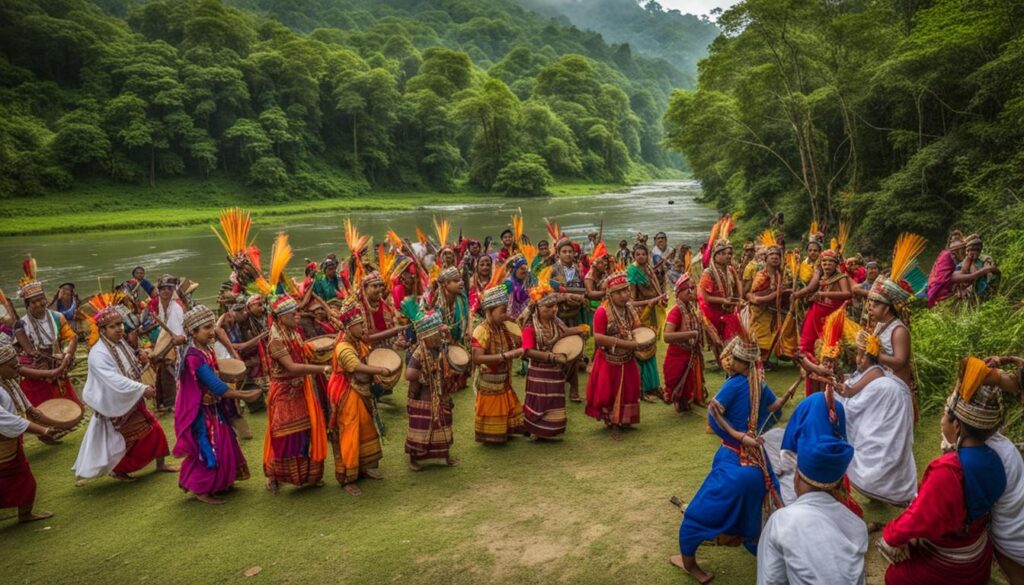
Experience the vibrant traditions and customs of the tribes of North East India during your visit. These tribes have a deep connection with nature and their cultural practices are often centered around celebrating the bounty of the land. The tribal festivals of North East India offer a glimpse into their rich heritage and provide an opportunity to witness captivating performances, traditional music, and exquisite craftsmanship.
One of the most notable festivals in the region is the Hornbill Festival, celebrated by several Naga tribes. This week-long extravaganza showcases the cultural diversity of the tribes through traditional dances, music, art, and sports. It is a vibrant celebration that attracts visitors from all over the world.
The Bihu and Bamboo Dance are other traditional dances that are unique to the region. Bihu, a harvest festival, is celebrated with great enthusiasm in Assam and marks the beginning of the agricultural season. The Bamboo Dance, performed by the Mizos, is a mesmerizing display of coordination and skill, as dancers move gracefully between bamboo poles.
While exploring the cultural beauty of North East India, don’t forget to indulge in the region’s delicious cuisine. The food in North East India is known for its distinct flavors and use of locally sourced ingredients. From the fiery dishes of Nagaland to the hearty momos of Sikkim, there is something to tantalize every taste bud.
Whether you are captivated by the colorful festivals, intrigued by the tribal traditions, or simply want to savor the flavors of North East India, immersing yourself in the cultural and natural beauty of the region is an experience like no other.
Best Time to Visit North East India for Wildlife Enthusiasts
For wildlife enthusiasts, the best time to visit North East India is during the winter season, from November to March. This is when the national parks of the region, such as Kaziranga National Park and Manas National Park, are open and offer the best wildlife sightings.

Experience the thrill of encountering rare and majestic creatures in their natural habitats. Kaziranga National Park, located in Assam, is a UNESCO World Heritage Site and home to two-thirds of the world’s population of Indian one-horned rhinoceroses. Explore the vast grasslands and dense forests as you spot various species of deer, wild elephants, and the elusive Bengal tiger.
Manas National Park, situated on the banks of the Manas River, is another wildlife haven. Embark on thrilling jeep safaris and witness the incredible diversity of flora and fauna, including golden langurs, Indian elephants, and the endangered Bengal florican. The park is also a sanctuary for elusive tigers and the rare pygmy hog.
Visiting these national parks during the winter season provides optimal wildlife viewing opportunities, as the vegetation is less dense, making it easier to spot animals. The weather is also more pleasant, with milder temperatures and fewer chances of rain, ensuring a comfortable and enjoyable wildlife safari experience.
| National Park | Best Time to Visit |
|---|---|
| Kaziranga National Park | November to March |
| Manas National Park | November to March |
Planning Your Trip: North East India’s Ideal Season for Travel
Navigating Through Summer’s Comfortable Climes
When planning your trip to North East India, it’s important to consider the ideal season for travel based on your preferences and the places you want to visit. If you prefer comfortable temperatures and sunshine, summer is the best time to explore the region. This is when popular tourist destinations are bustling with activities and the weather is perfect for outdoor adventures.
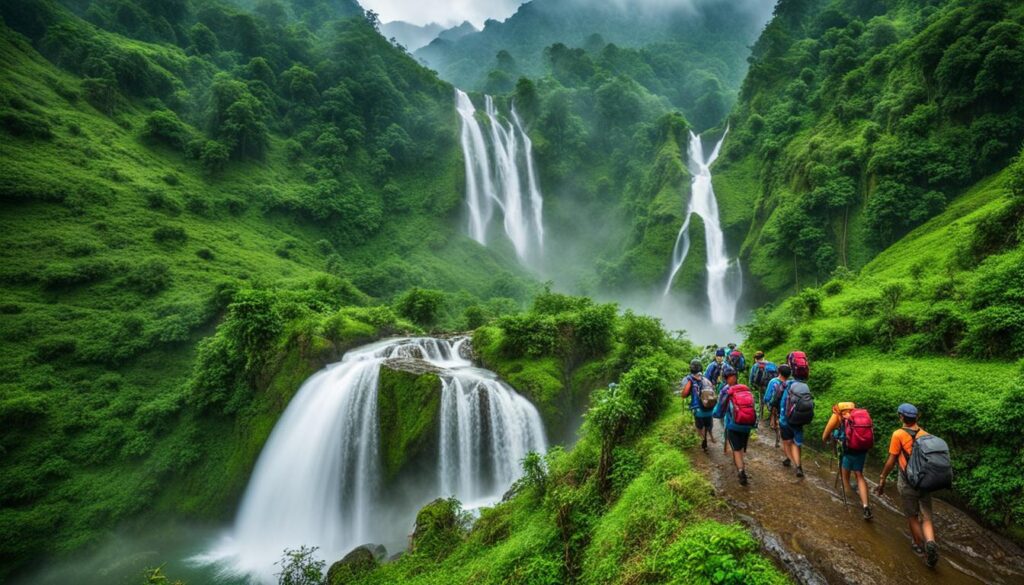
Embracing the Crisp-Cool Retreats of Winter
If you enjoy cooler temperatures and picturesque landscapes, then the winter season in North East India is perfect for you. With temperatures ranging from 12 to 22 degrees Celsius, you can experience the region’s beauty in a unique way. Winter is also the ideal time to witness snowfall in some areas, creating a magical atmosphere that is perfect for capturing breathtaking photographs.
Adventure Seekers: Peak Time to Visit North East India
For adventure seekers, the peak time to visit North East India is during the summer and post-monsoon seasons. These seasons offer ideal weather conditions for a plethora of thrilling adventure activities in North East India. From trekking through scenic mountain trails to experiencing the adrenaline rush of river rafting, paragliding, and camping amidst the stunning landscapes, there is something for every adventure enthusiast in this region.
The diverse natural topography of North East India, including hills, valleys, and rivers, provides a perfect playground for exciting adventures. Whether you are seeking an adrenaline-pumping experience or a peaceful trek in the wilderness, North East India offers a wide range of options to satisfy your adventurous spirit.
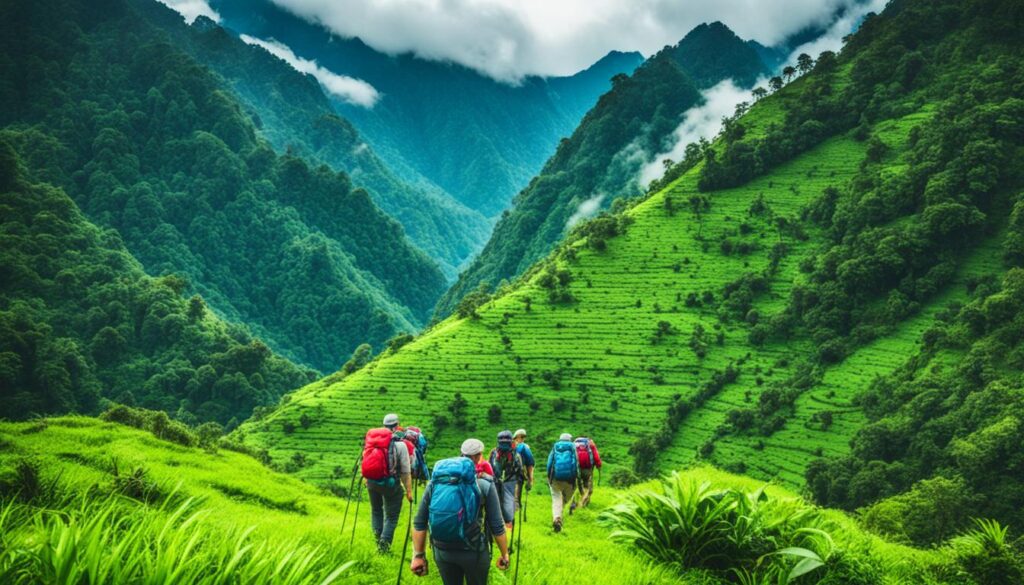
During the summer and post-monsoon seasons, the weather is favorable for outdoor activities, with mild temperatures and clear skies. It is the best time to embark on challenging treks, such as the Dzukou Valley trek in Nagaland or the Sandakphu trek in Sikkim, which offer breathtaking views of the Himalayan peaks.
For water sports enthusiasts, the rivers of North East India, including the Brahmaputra in Assam and the Teesta in Sikkim, provide thrilling opportunities for river rafting. The fast-paced rapids and stunning landscapes make it an exhilarating experience.
| Adventure Activity | Location | Peak Time |
|---|---|---|
| Trekking | Dzukou Valley, Nagaland Sandakphu, Sikkim | Summer and post-monsoon |
| River Rafting | Brahmaputra River, Assam Teesta River, Sikkim | Summer and post-monsoon |
| Paragliding | Gangtok, Sikkim Tawang, Arunachal Pradesh | Summer and post-monsoon |
| Camping | Dzuko Valley, Nagaland Dirang Valley, Arunachal Pradesh | Summer and post-monsoon |
No matter which adventure activity you choose, safety should be a top priority. Ensure that you are well-equipped with proper gear, follow all safety guidelines, and consider hiring experienced guides for your expeditions. It is also advisable to check weather conditions and carry sufficient provisions for your adventure.
Embark on an unforgettable journey of excitement and exploration by visiting North East India during the peak adventure season. Discover the region’s stunning landscapes, challenge yourself with thrilling activities, and create memories that will last a lifetime.
Celebrating with the Locals: Festivals of North East India
North East India is known for its vibrant festivals that showcase the rich cultural heritage of the region. The festivals provide an opportunity to immerse yourself in the local traditions, dance, music, arts, and crafts. These celebrations bring together communities and offer a glimpse into their way of life.
Hornbill Festival: A Fusion of Tribal Traditions
The Hornbill Festival, held in Nagaland, is the most famous tribal festival in North East India. It celebrates the heritage of the Naga tribes and promotes cultural diversity. The festival takes place annually in December and features a colorful display of traditional music, dance performances, indigenous games, and art exhibitions. Visitors can witness the captivating Hornbill International Rock Contest, taste traditional Naga cuisine, and explore the unique customs and rituals of the tribes.
Bihu and Bamboo Dance: The Rhythmic Heartbeat of the East
Bihu and Bamboo Dance are two popular traditional dances of North East India. Bihu, the harvest festival celebrated in Assam, is a joyous occasion filled with song and dance. The vibrant performances and lively beats of the dhol (traditional drum) and pepa (flute) create an energetic atmosphere. Bamboo Dance, also known as the Hojagiri dance, is performed by the Reang community in Tripura. Dancers balance bamboos while executing intricate movements, showcasing their agility and grace.
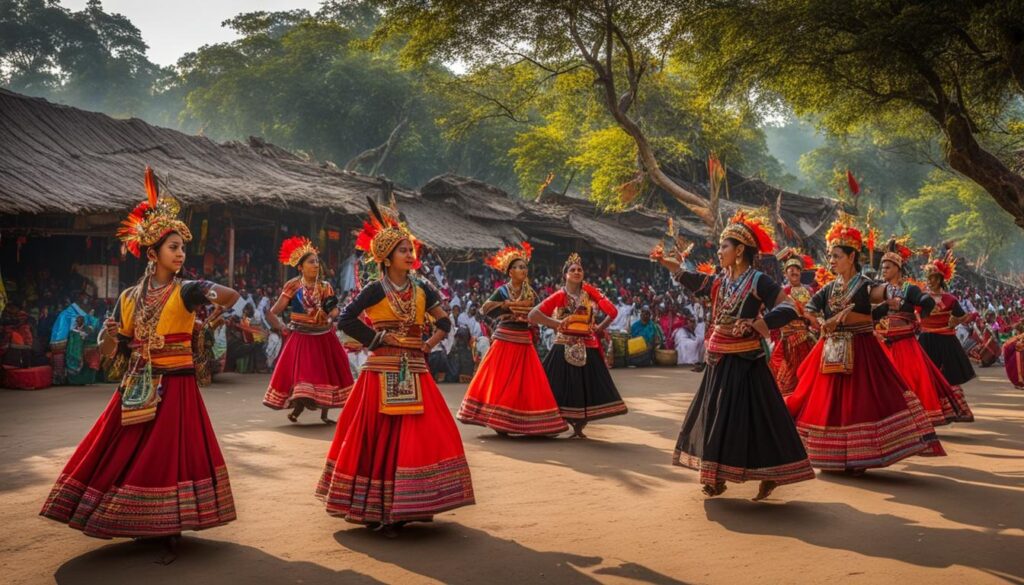
Exploring the Flavors of North East India: A Culinary Journey
North East India is a paradise for food lovers, offering a diverse range of flavors and traditional cuisines. Each state in the region has its own unique dishes and cooking techniques. From fish delicacies in Assam and bamboo shoot-based dishes in Meghalaya to momos and thukpa in Sikkim, the culinary journey in North East India is a treat for the taste buds.
Indulge in the aromatic and mouthwatering flavors of North East India food, where every bite is a fusion of regional spices and local ingredients. Sample the tangy and spicy dishes of Nagaland, try the authentic Assamese thalis, and savor the traditional Manipuri cuisine.
Experience the rich culinary heritage of the region as you delve into the traditional food of North East India. Discover the subtle balance of flavors and the use of unique ingredients such as bamboo shoots, fermented soybeans, and aromatic herbs. Prepare to be amazed by the bold and distinctive taste that defines the cuisine of North East India.
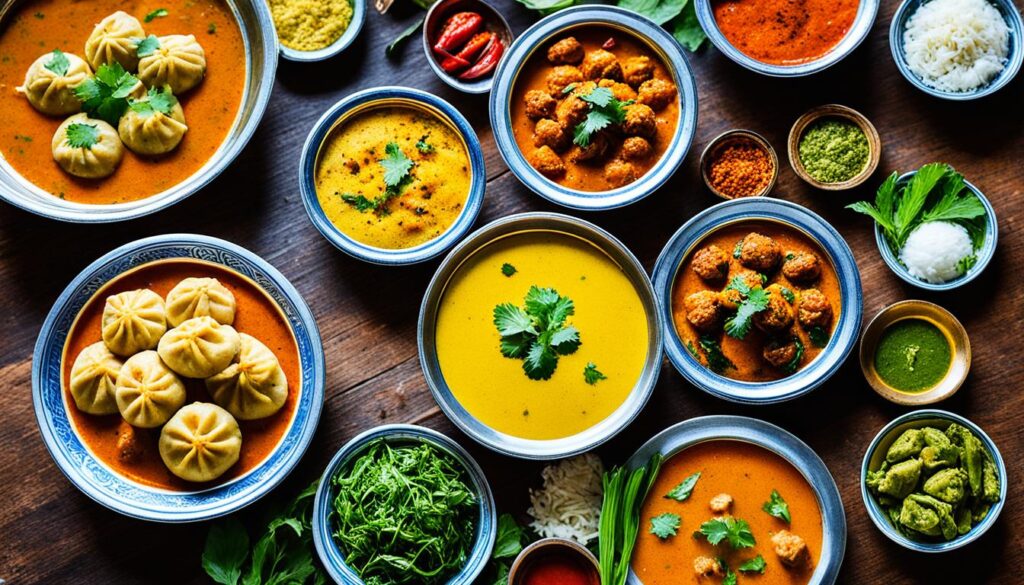
Immerse yourself in the vibrant street food culture of the region, where you can feast on a variety of snacks like momos, puchka, and jhalmuri. Enjoy the warmth of a steaming bowl of thukpa on a chilly evening or relish the delectable flavors of traditional sweets like Pitha and Rasgulla.
The culinary journey in North East India is not just about satisfying your taste buds but also understanding the cultural significance of food in the region. Explore local markets, interact with the friendly locals, and learn about the traditional cooking methods passed down through generations.
Whether you’re a food enthusiast or an adventurous eater, the traditional food of North East India promises to take you on a gastronomic adventure like no other. So, come prepared to embark on a culinary journey that will ignite your senses and leave you craving for more.
North East India Trip Itinerary: Optimal Period for a Memorable Experience
To have a memorable trip to North East India, it’s important to plan your itinerary according to the optimal period for each destination. Consider factors such as weather conditions, festival dates, and the specific attractions you want to visit. Some popular destinations in North East India include Kaziranga National Park, Tawang, Shillong, Gangtok, and the scenic landscapes of Meghalaya. Research and create a detailed itinerary to make the most of your time in the region.
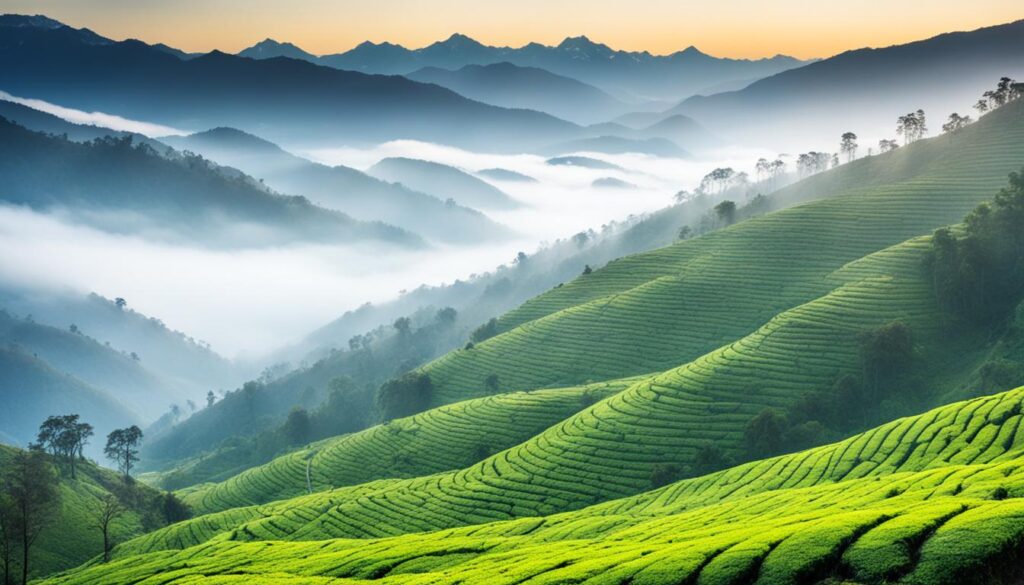
Planning your visit to North East India requires careful consideration of various factors to ensure a memorable experience. The region offers a myriad of attractions, from wildlife sanctuaries and picturesque landscapes to vibrant cultural festivals. By creating a well-structured itinerary, you can optimize your time and explore the top places in North East India. Below, we highlight some must-visit destinations that should be included in your itinerary:
- Kaziranga National Park: Home to the endangered one-horned rhinoceros, Kaziranga National Park is a must-visit destination for wildlife enthusiasts. The best time to visit this renowned national park is during the winter season, from November to March, when the park is open and offers excellent wildlife sightings.
- Tawang: Located in Arunachal Pradesh, Tawang offers breathtaking natural beauty and is famous for its ancient monasteries. The optimal period to visit Tawang is from April to October when the weather is pleasant, and the roads are accessible.
- Shillong: Known as the “Scotland of the East,” Shillong is the capital city of Meghalaya and offers stunning landscapes, waterfalls, and a vibrant culture. The best time to visit Shillong is during the summer months, from March to June, when the weather is pleasant and ideal for exploring the city’s many attractions.
- Gangtok: The capital city of Sikkim, Gangtok is a popular tourist destination known for its panoramic views of the Himalayas and Buddhist monasteries. The optimal time to visit Gangtok is from March to June and September to December, when the weather is pleasant, and the skies are clear for mountain views.
- Meghalaya’s Scenic Landscapes: Meghalaya offers a mesmerizing blend of lush green landscapes, caves, and living root bridges. The best time to visit Meghalaya is during the winter months, from November to February, when the weather is pleasant and rainfall is minimal.
By incorporating these destinations into your North East India itinerary, you’ll have the opportunity to explore the top places and create lasting memories in this beautiful region.
A Guide to Airports in North East India and Best Travel Routes
North East India is a captivating destination that offers a wealth of cultural and natural wonders. To explore this enchanting region, you can conveniently fly into one of the major airports that serve as gateways to North East India.
| Airport | Location |
|---|---|
| Lokpriya Gopinath Bordoloi International Airport | Guwahati |
| Netaji Subhash Chandra Bose International Airport | Kolkata |
| Bagdogra Airport | Siliguri |
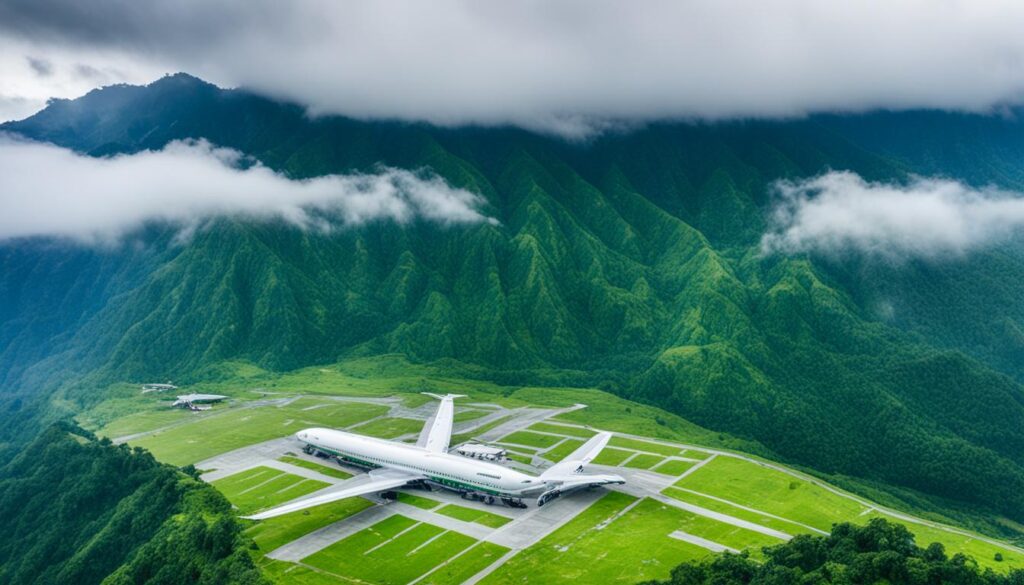
These airports provide excellent connectivity to both domestic and international destinations, making your journey to North East India hassle-free. Lokpriya Gopinath Bordoloi International Airport in Guwahati is the primary airport in the region, serving as a major hub for domestic flights. Netaji Subhash Chandra Bose International Airport in Kolkata also offers a range of domestic and international flights, providing convenient access to North East India from various parts of the world.
If you are planning to visit popular destinations in North East India such as Guwahati, Shillong, Kaziranga National Park, or the scenic landscapes of Meghalaya, flying into and out of these airports would be the most convenient option.
When it comes to the best travel routes to North East India, flying is often the preferred choice due to the long distances and challenging terrains. However, if you prefer a scenic road trip, there are well-established highways and road networks that connect North East India with other parts of the country. It’s important to note that road journeys to North East India may take longer due to the hilly terrain and winding roads. Therefore, it’s recommended to plan your travel routes and ensure proper rest stops along the way.
Whether you choose to fly or embark on a road trip, North East India welcomes you with its captivating beauty and warm hospitality. Get ready to explore the gateway to North East India and embark on a memorable adventure in this captivating region.
Understanding the Climate of North East India for Your Travel Plans
North East India is a region known for its diverse climate, which is influenced by its unique geographical location and varying elevations. Before planning your travel itinerary, it is important to understand the climate patterns that prevail in this enchanting part of India.
From Moderate Summers to Bone-Chilling Winters
Summers in North East India are generally mild to moderately warm. The temperatures during this season range from 22 to 38 degrees Celsius, providing a pleasant and comfortable environment for exploration and outdoor activities. It is the perfect time to visit popular tourist destinations in the region and indulge in experiences like boating, kayaking, and mountain biking.
As the summer season gives way to winter, North East India experiences bone-chilling temperatures. The winter season lasts from October to February, with temperatures ranging from 12 to 22 degrees Celsius. Some areas even witness snowfall, creating a mesmerizing winter wonderland. Winter is a great time to visit if you enjoy cooler temperatures and want to experience the beauty of snow-capped landscapes.
Embracing the Monsoons: The Lush Green Side of North East India
The monsoon season in North East India brings abundant rainfall, transforming the region into a lush green paradise. From June to September, heavy rainfall contributes to the vibrant green landscapes that make North East India truly enchanting. Though the incessant rain may limit some outdoor activities, it offers a unique opportunity to witness nature in all its splendor.
It is important to note that the climate in North East India can vary from state to state and even within different regions of the same state. So, when planning your travel, consider the specific weather conditions and climatic variations of the places you intend to visit.
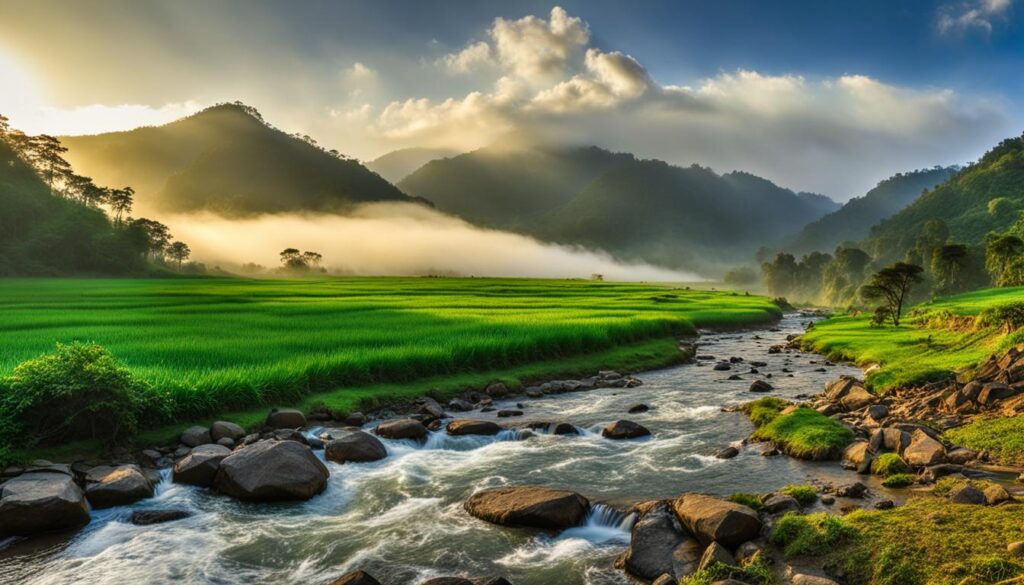
By understanding and considering the climate of North East India, you can plan your travel accordingly and make the most of your visit to this captivating region.
East India Tourist Places: When to Visit for the Best Experience
East India is a diverse and culturally rich region that includes states such as West Bengal, Odisha, Bihar, and Jharkhand. Each state offers unique tourist attractions and experiences. When planning your visit to East India, consider the best time to visit each destination based on weather conditions, festivals, and local events. Some popular tourist places in East India include Kolkata, Darjeeling, Puri, and Bodh Gaya.
Exploring East India is a treat for travelers seeking rich cultural experiences and breathtaking landscapes. Kolkata, the capital of West Bengal, is famous for its colonial architecture, vibrant festivals, and delicious street food. Be sure to visit the iconic Howrah Bridge and enjoy a boat ride along the River Hooghly.
In the hill station of Darjeeling, located in West Bengal, you can witness stunning views of the Himalayas and indulge in a cup of world-renowned Darjeeling tea. Take a ride on the charming Darjeeling Himalayan Railway, also known as the “Toy Train,” for a memorable experience.
In Odisha, the coastal city of Puri is known for its magnificent Jagannath Temple, a renowned pilgrimage site for Hindus. Explore the pristine beaches and immerse yourself in the local culture and traditions during the annual Rath Yatra festival.
Bodh Gaya, in the state of Bihar, is a significant Buddhist pilgrimage site where Gautama Buddha is said to have attained enlightenment. Visit the Mahabodhi Temple Complex and experience the peaceful atmosphere of this spiritual destination.
Plan your visit to East India based on the specific attractions and experiences you wish to explore. Whether you’re captivated by historical landmarks, fascinated by diverse cultures, or enchanted by natural beauty, East India offers a rich tapestry of experiences that will leave you with unforgettable memories.
Conclusion:
When planning your trip to North East India, it is crucial to consider the best time to visit based on your interests and the attractions you wish to explore. The region offers a wide range of experiences, from cultural immersion to wildlife encounters and adventurous activities. By taking into account the seasons, local festivals, and climate of the region, you can create an itinerary that guarantees a memorable and enjoyable experience in this enchanting part of India.
North East India is a treasure trove of cultural and natural beauty, waiting to be explored. Whether you want to witness the vibrant festivals, delve into the rich tribal traditions, savor the diverse cuisines, or embark on thrilling adventures, there is something for everyone in this region. The best time to visit may vary depending on your preferences and the specific places you plan to visit, so it is advisable to do thorough research and plan accordingly.
With pleasant weather conditions, lesser chances of rain, and a multitude of attractions, the ideal season for travel in North East India is between November and May. However, it’s important to note that each season has its own charm. Summertime offers comfortable temperatures for outdoor activities and exploration, while the winter season brings a touch of magic with its crisp-cool retreats and the possibility of snowfall in some areas. The refreshing monsoon season presents lush green landscapes, perfect for nature lovers.
FAQs:
Q: What is the best time to visit North East India?
A: The best time to visit North East India is between November and May, as this period offers the best weather conditions and least chance of rain.
Q: What are the seasons in North East India?
A: North East India experiences three distinct seasons – summer, winter, and monsoon.
Q: What is the summer season like in North East India?
A: The summer season in North East India, which lasts from April to June, is characterized by pleasant weather with temperatures ranging from 22 to 38 degrees Celsius.
Q: When is the best time to visit North East India for wildlife enthusiasts?
A: The best time to visit North East India for wildlife enthusiasts is during the winter season, from November to March, when the national parks in the region are open and offer the best wildlife sightings.
Q: What are some popular tourist places in East India?
A: Some popular tourist places in East India include Kolkata, Darjeeling, Puri, and Bodh Gaya.
Q: What are some popular festivals in North East India?
A: Some popular festivals in North East India include the Hornbill Festival in Nagaland, which showcases the traditional music, dance, arts, and crafts of various tribes, as well as the Bihu and Bamboo Dance.
Q: What is the culinary scene like in North East India?
A: North East India is a paradise for food lovers, offering a diverse range of flavors and traditional cuisines. Each state in the region has its own unique dishes and cooking techniques.
Q: How should I plan my trip to North East India?
A: When planning your trip to North East India, it’s important to consider the ideal season for travel based on your preferences and the places you want to visit. Research and create a detailed itinerary that takes into account factors such as weather conditions, festival dates, and specific attractions.
Q: What are the airports in North East India?
A: Major airports in North East India include Lokpriya Gopinath Bordoloi International Airport in Guwahati, Netaji Subhash Chandra Bose International Airport in Kolkata, and Bagdogra Airport in Siliguri.
Q: What is the climate like in North East India?
A: North East India has a diverse climate due to its geographical location and varying elevations. Summers are generally mild to moderately warm, winters are cold, and the monsoon season brings heavy rainfall and lush green landscapes.
Q: When is the best time to visit East India?
A: The best time to visit East India depends on the specific destinations and activities you plan to engage in. It’s important to consider factors such as weather conditions, festivals, and local events when planning your visit.
